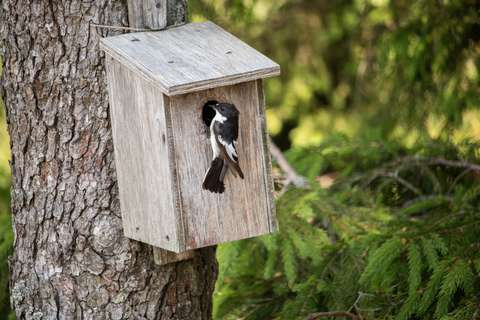Tips for helping nature
Every one of us can, through our own actions, protect biodiversity. This page includes a collection of tips for how you can safeguard biodiversity through small practical actions.
Did you know that a fully-grown tree is a real treasure? On hot days, trees provide shade and cool their surroundings, and on rainy days, their roots absorb water effectively. Trees also provide nourishment and a habitat for numerous birds, insects and fungi. Read more from the brochure and get to know, how you benefit from trees on your courtyard and how to preserve any trees growing on your plot during construction: Stand by your tree: why you should save your tree and how
Helping nature in your own garden
Yards and gardens can be diverse and sheltered habitats for many species to thrive in. Maintaining a garden with natural means does not mean having an untidy garden; instead, it means having a garden whose vegetation, life and nature reflect the natural growing conditions of the garden.
In your own garden, you can maintain biodiversity through plant selections: favour species that can also be found in Finnish nature. Domestic plant species have adapted to the conditions prevailing here, and foreign seedlings may bring with them invasive species and pesticides that are dangerous for pollinators. Bees, bumblebees and butterflies will thank you for choosing for your garden pollinator-friendly plants that bloom at different times and provide pollinators with food throughout the growing season.
In nature, nutrients circulate locally, so if you are mowing the lawn, leave the clippings and leaves on the ground to enrich the soil. Organic matter and plant parts such as compost, manure, ash, various mulches, grass clippings, twig chips and other decomposable material work well as organic fertilizers. Establishing a wildflower meadow is truly an act for the environment!
As a result of effective forest management, there is too little decaying wood in our forests, which is why many species dependent on decaying wood are in danger of disappearing. Decaying wood can be utilised in yards and gardens in a variety of structures such as a fence built of decaying twigs and branches or border structures for plantings. For example, flower beds or garden paths can be bordered with blocks of wood. If you cut down a tree, leave as high a stump as possible in the yard to provide the organisms living in your yard with enough decaying wood for a long time.
If you have a pond or some wetland in your yard, you can provide a habitat for many aquatic and waterside plants and organisms that thrive in humid conditions. At the same time, the pond can be a tool for managing stormwater locally.
Biodiversity can also be maintained in a block of flats. Set up a balcony box with pollinator-friendly flowers or suggest that your housing company make the courtyard more diverse with flowering plants, a courtyard pond or a fence made of decaying wood.
Easy building and crafting instructions
Building nesting boxes and artificial nests is both a nice pastime and a great help to birds, bats and hedgehogs. Decaying wood can be utilised in many yard or garden structures such as a fence built with decaying twigs and branches or border structures for plantings.
Remember that before you can hang a nesting box for birds or bats, you need to have the landowner’s permission. Hanging nesting boxes in city-owned forests is not allowed.
Working together for the nature in Espoo
In Espoo, residents, associations, communities, educational institutions and companies can take responsibility for the management of their local environment and contribute to the work supporting urban biodiversity. There are many different ways to take care of local nature, and you can choose the one that suits you the best. In addition, there are many nature conservation organisations and resident associations in Espoo that you can participate in. More information about different forms of volunteer work can be found on the Clean-up events webpage.
Espoo encourages associations and communities to work to promote biodiversity and is happy to cooperate with residents in nature restoration projects. Contact Environmental Protection to present your ideas.
How you can support biodiversity:
- Organise or participate in a volunteer effort. Many invasive plant species have spread to vast areas in Espoo and fighting them through community effort is important. Species that are particularly suitable targets for volunteer work are the Himalayan balsam, the rugosa rose and the lupin. More information about invasive species and the organisation of volunteer work is available on the Invasive species webpage.
- Join an effort for traditional landscapes. A significant portion of Finland's endangered plant species grows on meadows, and many insects are also dependent on meadow plants. Every August, the traditional landscape in the Laajalahti nature reserve is preserved through volunteer work. The activities included in the work are suitable for the whole family. You can ask for more information about the volunteer effort from Nature House Villa Elfvik.
- Plan a waterbody restoration project and apply for a grant. When it comes to restoring and managing waterbodies whose natural state has deteriorated, active local effort is particularly important. Environmental Protection grants annually support for measures that aim to restore waterbodies in Espoo. More information and application instructions can be found on the Vesistökunnostusavustukset (in Finnish) webpage.


